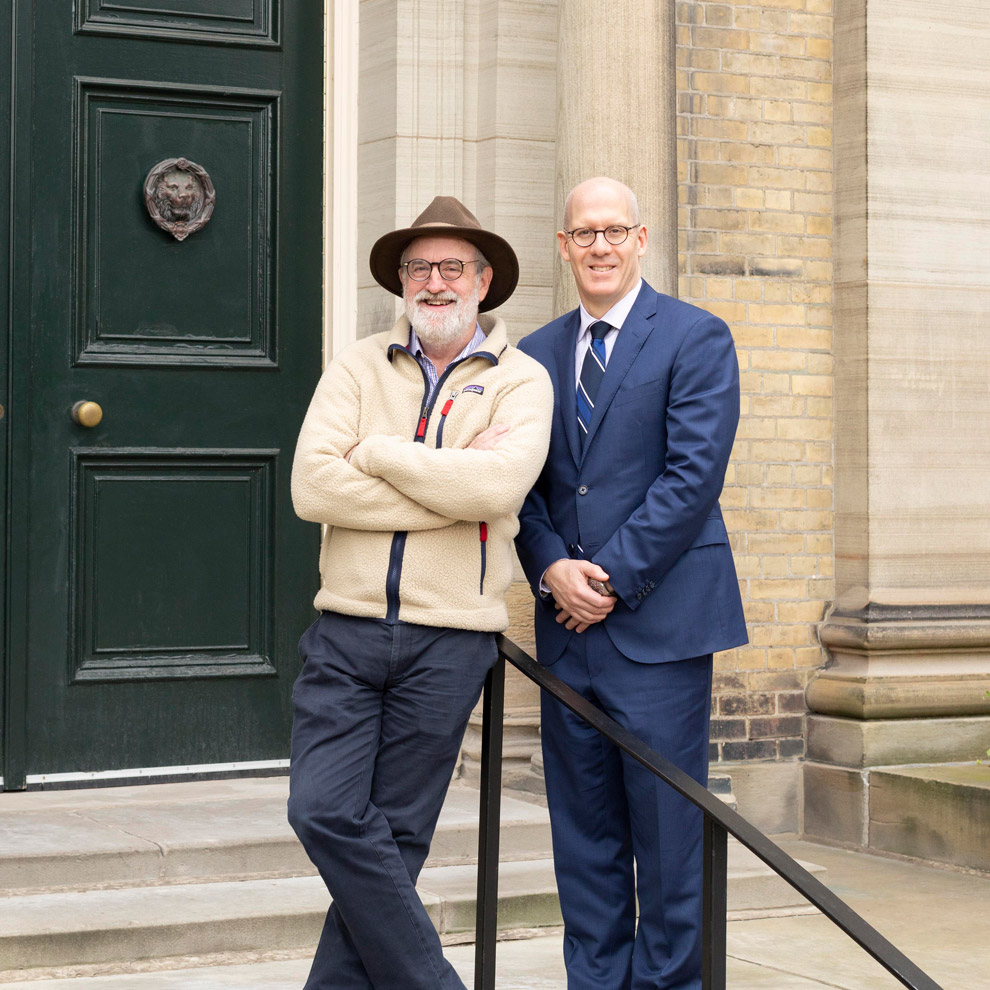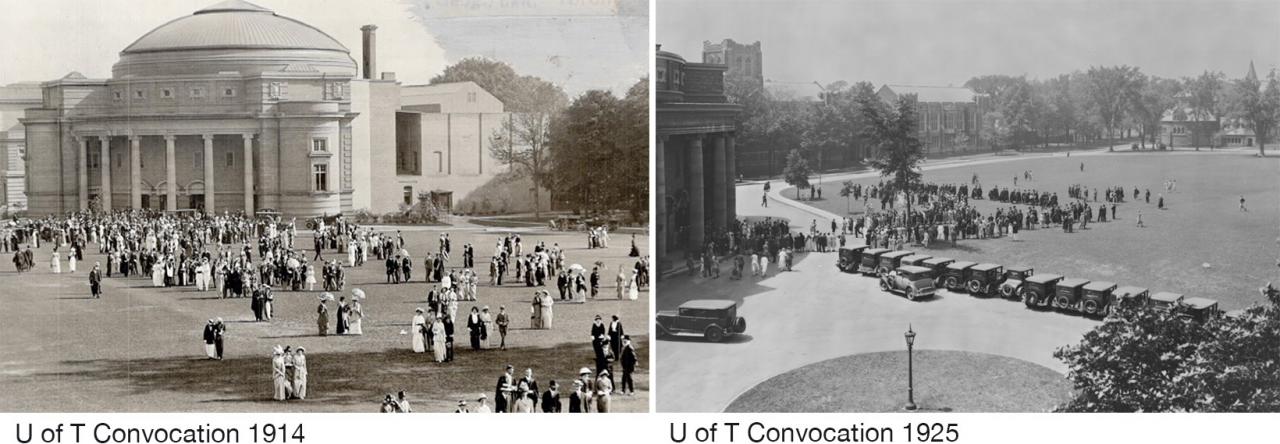Stories of Support
A Q&A with Landmark project champions Donald Ainslie and Scott Mabury
The Principal of University College and U of T’s Vice-President, University Operations answer your questions about the Landmark Project, and share their personal connection to the initiative.

The Landmark Project is one of the most significant open space projects to take place on the St. George campus since the 19th century. This extraordinary initiative will reclaim the historic campus core for pedestrians by moving surface parking on King’s College Circle (KCC) and Hart House Circle underground and introducing new plazas, pathways, trees and gardens to create a campus experience more befitting a world-class University.
When completed, the space will once again serve as the thriving centre of campus, shaping and elevating the experience for students, alumni, faculty, staff and the wider Toronto community.
Recently, we sat down for a chat about the Landmark Project with academic co-leads Professor Donald Ainslie, Principal of University College (UC), and Professor Scott Mabury, Vice-President, University Operations and Vice-Provost, Academic Operations.
We often say that the Landmark Project is an exciting opportunity for people with U of T connections to leave their mark on the historic core of the University of Toronto. Both of you have generously contributed to the project. What does leaving your mark mean to you?
DONALD AINSLIE: It means a lot to me. I’ve chosen to donate a garden outside University College, which will be named after my grandparents Donald S. and J. Dorothy Ainslie. My grandfather graduated from UC as a physics major in the middle of the First World War. He was sent overseas to conduct research on sonar for the war effort and was billeted with a widow and her two daughters in a house on the west coast of Scotland. When the war ended, he came back to Canada, but he kept up a correspondence with one of the daughters. They fell in love, and eventually, she came to Canada, and they got married, and that’s my grandmother. She was a great gardener, so a garden in their names feels particularly appropriate.
Wow. That’s such a great story.
DA:It really is. My grandfather eventually became a physics professor at U of T, and many other members of my family went to U of T. I was the exception. But as principal of UC, living and working on campus, I feel a deep personal as well as family connection to U of T. I wanted to contribute to this project because I deeply believe in it, but also because I want to acknowledge my family’s U of T roots. When I told my family about it, they thought it was perfect. And I agree. It’s the right way to acknowledge my grandparents and a wonderful way to remember the time my husband and I have spent living here.
SCOTT MABURY:It means a great deal to me too. I’m also not a graduate of U of T. In fact, I’m not originally Canadian. But when my wife and I were considering where we wanted to make our home—professionally and personally—U of T and Toronto seemed perfect for us. My daughter was two years old at the time, and we thought this is where we’d like her to grow up. So when my wife and I decided to donate a garden to the Landmark Project, we chose to name it after our daughter, Scotia Autumn. As a chemist, I asked that the garden be located near the Croft Chapter House, named for Henry Holmes Croft, who established the University’s first chemistry laboratory at that site.
For the past two years, you’ve both been working tirelessly to promote the Landmark Project. How are people responding to the proposed transformations to the St. George campus?
DA:Well, as I mentioned, as principal of UC, I have the privilege of living on St. George campus, and have for seven-and-a-half years now. Being here 24-7, you get a sense of how much our students, faculty, staff, alumni and the broader downtown community use the campus. It’s a unique and special space in the heart of the city that people from all walks of life cherish. They’re invested in what happens to it. Every time I sketch out what we’re doing, almost immediately people get it; they agree an improvement on this scale is long overdue. Our students, faculty, and alumni are incredibly engaged and are supporting the Landmark Project in unprecedented numbers.
SM:I have the same experience. I think the project is capturing the interest of the U of T community because the landscape of this part of campus is so enduring. When we talk about the Landmark Project and share the renderings, it captures people’s hearts and imaginations. People want a campus that not only reflects our standing as one of the world’s top research universities, but also works at the human level. And they want to be part of this historic transformation.
DA:The human element is really central to what we’re doing with the Landmark Project. We started thinking about our campus in a more holistic and human-oriented way in the mid-1990s when St. George Street was redesigned. At that time, we redesigned King’s College Road and some of the pathways connecting King’s College Circle to St. George Street. But we stopped short of taking on the traffic problem and what I’m hearing now is how happy people are that we’re finally doing that. Not only are we going to make Front Campus and Hart House Circle more beautiful, accessible and environmentally sustainable, but we’re also going to make it a far nicer experience to walk from class to class or to meet up with friends.
Improving the pedestrian experience is a major part of the Landmark Project. Can you talk a little bit more about why reducing parking and traffic around KCC and Hart House Circle is such an important step for the University?
SM:The historic core of campus is hallowed ground. It’s the one place on campus to which all graduates have a connection. But when you look at how it functions now, it puts cars before the users of the space. Around KCC, for example, we often have two rows of parking, plus people driving—sometimes faster than they should—then hundreds of students come out of Convocation Hall, and we’re all squeezed into this little space. It doesn’t work. It’s not how the space was designed to function. And that’s one of the biggest issues the Landmark Project is addressing.
DA:We really want to make this area of campus work for everyone. As Scott alluded to, KCC was designed almost two-hundred years ago, way before the automobile era. When the car came into use in the early 20th century, it came very quickly. I have these amazing photos, one of Convocation in 1914, and another of Convocation in 1925. In the first photo, I think it was June 1914 so the First World War is about to start, the campus is quiet, pastoral and idyllic. But in the background, there are a couple of cars. It’s just the beginning. A decade later, there are cars all over KCC during Convocation.

SM:And obviously people were thrilled at the ease of transit it provided. But the University didn’t think through how to make our spaces work with cars. King’s College Circle was planned and built thinking about pedestrians. How the buildings are placed, their elevations are all at the human scale, not at the vehicle scale. Our architects understand this and their plan is returning the area to pedestrians. It’s very exciting. It will make a huge difference to how we experience the space. And this seems to really resonate with people.
Q: Can you also speak about how the Landmark Project is also going to strengthen the University’s relationship with Toronto and surrounding neighbourhoods?
SM:I think historically the University was more inward-looking. We saw ourselves as separate, isolated from the city to some degree. Even physically, we had our backs to the city and the surrounding neighbourhoods. But that’s changed. We no longer see ourselves as separate or distinct. We want to integrate U of T into the fabric of the city and community.
DA:And what better person to lead this charge than President Meric Gertler, an economic geographer who understands cities and how everybody benefits when universities engage with the broader community. We’re much more outward-looking now. So much more porous. We’re saying, “Come in.” We want to be firmly part of the broader urban community. The Landmark Project is a key part of taking down barriers and saying, “You are all welcome here.”
Q: Can you talk a bit about the project timeline?
SM:Well, it’s difficult to put a firm timeline on a project of this size and scope. But I can say that things are really starting to come together. Right now, we’re in the midst of the staging process. I liken it to painting a room. Before you can start, you have to tape and prime the surfaces. Take King’s College Green, for example. Nobody ever thought that we would build usable space underneath it. So there are things that have to be dealt with before we can break ground—underground power lines, steam pipes, wireless connections. We’re dealing with all those first, because we can’t expect folks to go without wireless. Or power. Or warmth in the wintertime!
DA:And because of all the changes happening in that area, we’ve got opportunities to do some exciting things. Right now, for example, we’re looking at installing a major geothermal field beneath KCC, which would save us 15,000 metric tons of greenhouse gas emissions a year—a major contribution to greening our campus and achieving our 2030 commitment to sustainability.
Q: Thank you both for talking with me today. Before we say goodbye, do you have any final thoughts?
SM:I think I can speak for Donald when I say that for both of us and our families, being part of this historic initiative has been a once-in-a-lifetime opportunity. We encourage everyone to get involved. Read our donor stories, take a look at the renderings and discover how you too can leave your mark!
Posted on December 11, 2018